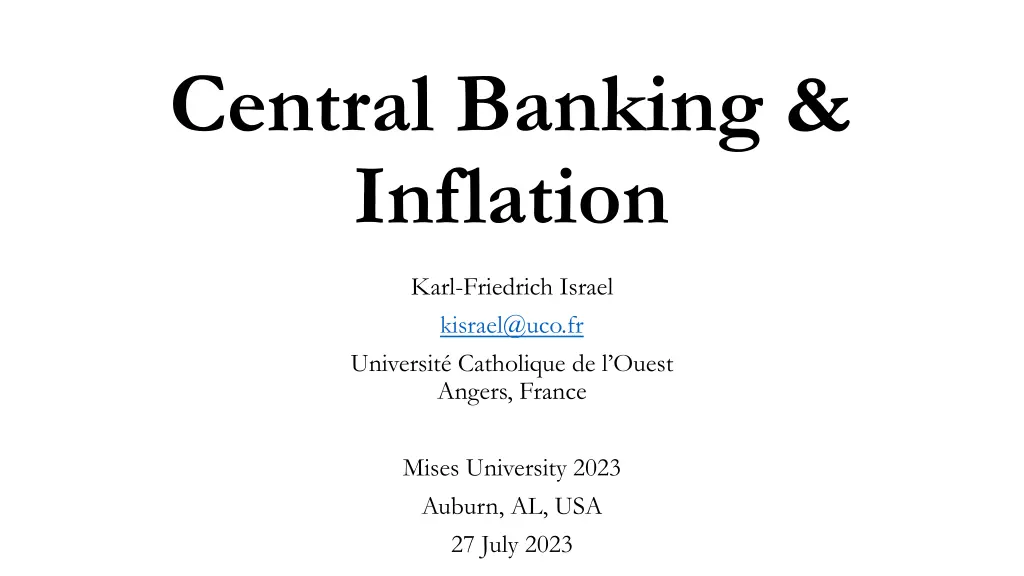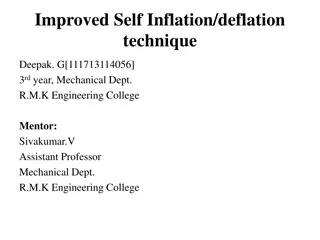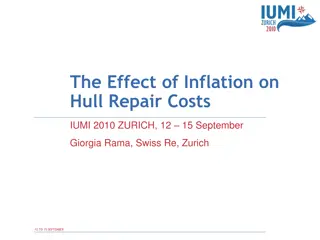
Understanding Central Banking and Inflation Measures
Explore the role of central banks in managing inflation, the challenges in measuring inflation, and its impact on social mobility. Get insights from alternative inflation measures proposed by K.-F. Israel and G. Schnabl. Discover how inflation affects economies like the Eurozone and the USA.
Download Presentation

Please find below an Image/Link to download the presentation.
The content on the website is provided AS IS for your information and personal use only. It may not be sold, licensed, or shared on other websites without obtaining consent from the author. If you encounter any issues during the download, it is possible that the publisher has removed the file from their server.
You are allowed to download the files provided on this website for personal or commercial use, subject to the condition that they are used lawfully. All files are the property of their respective owners.
The content on the website is provided AS IS for your information and personal use only. It may not be sold, licensed, or shared on other websites without obtaining consent from the author.
E N D
Presentation Transcript
Central Banking & Inflation Karl-Friedrich Israel kisrael@uco.fr Universit Catholique de l Ouest Angers, France Mises University 2023 Auburn, AL, USA 27 July 2023
Content 1. Introduction 2. Some Problems with Inflation Measures 3. Inequality and Social Mobility 4. Further Implications Reference: K.-F. Israel and G. Schnabl, Alternative measures of price inflation and the perception of real income in Germany. The World Economy, (2023, forthcoming)
1. Introduction Central Banks in modern fiat money systems hold a legal monopoly in the production of base money (M0 = cash money in circulation + bank reserves) M1 (= cash money in circulation + demand deposits) is only indirectly controlled through monetary policies, such as Legal reserve requirements Interest rate policies Open market operations Unconventional asset purchase programs Monetary policy target: 2% price inflation rate
2. Some Problems with Inflation Measures How to measure inflation? Inflation in the classical sense is just an expansion of the money stock (the only objectively measurable type of inflation) Inflation in the modern sense is an average increase in money prices (price inflation) What prices? What average? Goal: how much more money does it cost to buy a certain degree of want satisfaction or to enjoy a certain standard of living? No objective price level or rate of price inflation
HICP inflation 14 France 12 Germany 10 ECB target 8 % per year 6 4 2 0 -2 -4 1999 2003 2007 2011 2015 2019 2023 Data Source: Eurostat
CPI Inflation 14 USA 12 Target 10 8 % per year 6 4 2 0 -2 -4 1998 2002 2006 2010 2014 2018 2022 Data Source: Bureau of Labor Statistics
M1 money stock and real GDP in the Euro area 800 700 M1 money stock 600 Index (Dec. 1998=100) 500 400 300 200 100 0 1998 2002 2006 2010 2014 2018 2022 Data Source: ECB Data Warehouse, Eurostat
M1 money stock and real GDP in the Euro area 800 M1 money stock 700 Real GDP 600 Index (Dec. 1998=100) 500 400 + 6.8 perc. points of annual excess money growth 300 200 100 0 1998 2002 2006 2010 2014 2018 2022 Data Source: ECB Data Warehouse, Eurostat
M1 money stock and real GDP in the US 12000 10000 M1 money stock Index (Dec. 1970=100) 8000 Real GDP 6000 4000 2000 0 1971 1983 1995 2007 2019 Data Source: Federal Reserve Economic Data
M1 money stock and real GDP in the US 500 M1 money stock 400 Index (Dec. 1998=100) + 5.6 perc. points of annual excess money growth real GDP 300 200 100 0 1999 2002 2005 2008 2011 2014 2017 2020 Data Source: Federal Reserve Economic Data
2. Some Problems with Inflation Measures How can the gap be explained? 1. Demand for money has increased 2. Price index (CPI/HICP) underestimates price inflation Why does the index underestimate price inflation? 1. It is downward biased 2. There is inflation outside the basket of goods and services used for the index
2. Some Problems with Inflation Measures Two possible sources for bias in the index 1. Substitution effects / changes in consumption behavior 2. Quality changes
2. Some Problems with Inflation Measures Substitution effects Example: Coca Cola (1% price increase) and Pepsi Cola (5% price increase) Initial expenditure shares 50% and 50% Updated expenditure shares 80% and 20% Inflation rate with initial shares: 0.5 1% + 0.5 5% = 3% Inflation rate with updated shares: 0.8 1% + 0.2 5% = 1.8% What is the correct rate?
2. Some Problems with Inflation Measures Quality changes Quality improvements are like an implicit decrease in price / Quality deteriorations are like an implicit increase in price More and more explicit quality adjustments are implemented (e.g.: hedonic price adjustments) Example: Computer Model 1 at $ 1,000 (3.0 GHz CPU) is replaced by Computer Model 2 at $ 1,100 (3.3 GHz CPU) The monetary value of a 0.3 GHz increase is estimated to be $ 80 Price increase is 2% instead of 10%
2. Some Problems with Inflation Measures CPI / HICP focuses exclusively on present private consumption It excludes expenditures for: Future consumption / saving (assets, such as stocks and real estate) Public goods (government spending) There is overproportionate price inflation in the neglected areas
2. Some Problems with Inflation Measures Overproportionate asset price inflation as a result of changes in saving behavior Decrease in demand for assets that lose purchasing power (cash, deposits) Increase in demand for assets that protect against inflation (stocks, real estate) Germany: DAX at 5,007 on December 30, 1998, and at 15,640 on July 7, 2023 increase of 4.8% annually From February 14, 2023 (13,744) to December 30, 2021 (15,885): 8.0% annually
Housing Prices 300 250 Index (2000=100) 200 150 100 50 France Germany 0 2000 2004 2008 2012 2016 2020 Data Source: Insee (Idbank: 010001868), German Bundesbank (BBDR1.A.DEA.N.BBKL.WHK.P.I10.A)
Housing Prices 300 250 Index (2000=100) 200 150 100 France HICP France Germany HICP Germany 50 0 2000 2004 2008 2012 2016 2020 Data Source: Insee (Idbank: 010001868), German Bundesbank (BBDR1.A.DEA.N.BBKL.WHK.P.I10.A)
3. Inequality and Social Mobility Distributive effects lead to greater inequalities There are 4 important channels of redistribution: From private to public From relatively poor to relatively wealthy strata of the population From labor income to capital income and capital gains From younger to older generations Overproportionate asset price inflation drives up the wealth to income ratio and undermines social mobility
Net wealth to net income ratio 8 7 6 5 Ratio 4 3 2 France Germany 1 0 1990 1994 1998 2002 2006 2010 2014 2018 2022 Data Source: World Inequality Data Base
Net wealth to net income ratio and housing prices Great Recession 8 300 7 250 Introduction of the Euro 6 200 Index (2000=100) 5 150 Ratio 4 100 3 50 2 0 France Germany 1 -50 French House Prices (right) German House Prices (right) 0 -100 1990 1994 1998 2002 2006 2010 2014 2018 2022 Data Source: World Inequality Data Base, Insee (Idbank: 010001868), German Bundesbank (BBDR1.A.DEA.N.BBKL.WHK.P.I10.A)
Net wealth to net income ratio 7 USA 6 5 4 Ratio 3 2 1 0 1970 1975 1980 1985 1990 1995 2000 2005 2010 2015 2020 Data Source: World Inequality Data Base
4. Further Implications A sense of injustice is spreading in the face of rising inequality Resentment toward public institutions, politics, and the economic system Collective corruption Decreasing voter participation in elections and a shift from center parties to politically more extreme parties on the left and right More widespread hedonistic life-style choices (more consumerism, less frugality) as the opportunity costs of building up wealth over time have increased Existential fears and despair






















